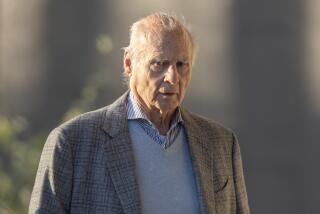O.J. or Winona, old pack mentality rules
Winona Ryder’s trial is surely the least important ever to be given the media’s version of a full-court press. Let’s face it: At the end of the day, this was a trial for shoplifting.
There were no bodies, no sex, no illicit drugs, no racial issues nor any of the other allegedly significant attributes editors and producers usually cite to justify the sort of round-the-clock, floor-to-ceiling coverage Ryder’s trial and conviction received. This was, in fact, a trial about hair bows and mutilated blouses -- albeit absurdly pricey ones. No responsible journalist whose employer derives substantial revenues from department store advertising ever would minimize Saks’ $5,560 loss. But an ambitious East Valley tagging crew does about that much dollar damage on a good Friday night.
As juror Walter Fox told The Times’ Anna Gorman, “I do believe that this was much ado about nothing.”
So, what was all this about?
The conventional answer is that the news media simply pander to our society’s well-documented obsession with celebrity. That’s part of the answer -- for part of the press. The other, equally important part is that each of the milestones in American journalism’s 127-year history of preposterously extravagant trial coverage coincides with a significant shift in news-gathering capabilities.
The wretched Ryder’s trial is such a milestone because it marks the expansion of the kind of coverage previously accorded so-called “trials of the century” to the truly trivial. In this case, the engine driving the process was the fragmentation of the recently created 24-hour cable news cycle into a bitterly competitive marketplace in which CNN, Fox, MSNBC, Court TV and a variety of entertainment channels are fighting for viewers. The result is a circus, and, in this instance, everybody else was pulled into the tent.
For the record, Santa Clara University Law School professor Gerald Uelman believes at least 33 cases over the last 127 years have been called “trials of the century.” Some, like the prosecutions of Nicola Sacco and Bartolomeo Vanzetti, John Thomas Scopes, the Scottsboro Boys, Julius and Ethel Rosenberg, and Daniel Ellsberg, involved issues worthy of the appellation.
Most involved situations more like the one that enmeshed Ryder, including the first such event:
In 1875, New York editor Theodore Tilton discovered that his wife was engaged in an affair with his best friend, famed preacher and abolitionist Henry Ward Beecher. Tilton sued Beecher for “alienation of affection.” The six-month trial that followed in Brooklyn City Court gripped the imagination of the nation’s leading city. As one contemporary source described it: “The proceedings provided the chief entertainment in town. Tickets were black-marketed at $5 apiece, and as many as 3,000 persons a day were turned away, affording nearby saloons a booming business. Prominent politicians, diplomats and society leaders fought for seats in the courtroom with ordinary curious folk and went without their lunch in order to hold them, or bought sandwiches and soft drinks from vendors,” who were allowed to hawk their wares inside the courthouse.
But what transformed a local entertainment into a national preoccupation were newspapers with new news-gathering techniques to deploy. By the 1860s, Americans read more newspapers on a per capita basis than any other people in the world. But there hadn’t been a gripping national story since Appomattox. Editors across the country saw an opportunity in the Beecher trial and dispatched as many as 10 reporters -- the first recorded example of what we now call “pack journalism” -- to cover it. Equally important, a new generation of sketch artists was posted in the upper stories of nearby buildings with spyglasses. The artists provided daily drawings of the jurors, whose various postures were analyzed by commentators. The backgrounds of individual jurors were exhaustively investigated by the press, which subsequently hounded many of them out of town when they failed to reach a verdict.
Thirty-two years later, changes in the media created another such New York trial that gripped the country. Harry Thaw, a Midwestern millionaire and sexual sadist, shot society architect and playboy Stanford White for the alleged seduction of his wife, sometime actress Evelyn Nesbit. Thaw’s 1907 trial -- which plays a part in E.L. Doctorow’s novel “Ragtime” -- coincided with a vicious new circulation war between the Hearst and Pulitzer newspapers, as well as the advent of the sensational style of reporting that came to be called “yellow journalism.”
New advances in reproduction allowed the first widespread use of photographs of the trial participants. The result was attention so intense that Western Union had to open an office exclusively devoted to transmitting daily reports from the courtroom. The reporting contained in them was, by the standards of the day, so salacious that the postmaster general considered banning the delivery of popular newspapers through the mail.
After two trials, Thaw was found not guilty by reason of insanity. He suffered, according to his defense attorney, Delphin Delmas, from “dementia Americana,” a madness peculiar to American males whose wives’ purity has been violated.
In 1935, Bruno Richard Hauptmann was tried for the kidnapping and murder of Charles and Anne Lindbergh’s 20-month-old son.
Lindbergh’s epic solo flight across the Atlantic had made him the darling of a burgeoning new popular media that had recently discovered the commercial possibilities of celebrity. His life seemed to blend traditional American frontier heroism with technological achievement. When Hauptmann’s trial began, more than 700 print and radio journalists and hundreds of radio and telephonic technicians descended on the little town of Flemington, N.J., where the case was tried.
To serve the reporters, the local utility installed the largest special-purpose telephone system in the world, one sufficient to serve 1 million people. Radio correspondents were allowed to broadcast live from the courtroom and, for the first time, newsreel cameramen were allowed to film the court proceedings.
It was, according to H.L. Mencken, “the biggest story since the Resurrection,” and it resulted in a guilty verdict about which doubts still linger.
A clearer miscarriage of justice occurred in 1954, when the trial of Dr. Sam Sheppard was dominated by the coverage of syndicated columnists and radio commentators, who then were at the height of their journalistic influence, commanding a following few editors were willing to challenge.
There is no need to recount the recent history of television’s intrusion into the courtroom, which began with the William Kennedy Smith trial, passed through that of the Menendez Brothers and ended in the electronic Armageddon that consumed Judge Lance Ito’s courtroom during the O.J. Simpson trial.
As the Ryder trial demonstrates, technology and competition have taken the media to the edge of another precipice from which the sane and sober might wish to draw back.
More to Read
The biggest entertainment stories
Get our big stories about Hollywood, film, television, music, arts, culture and more right in your inbox as soon as they publish.
You may occasionally receive promotional content from the Los Angeles Times.










